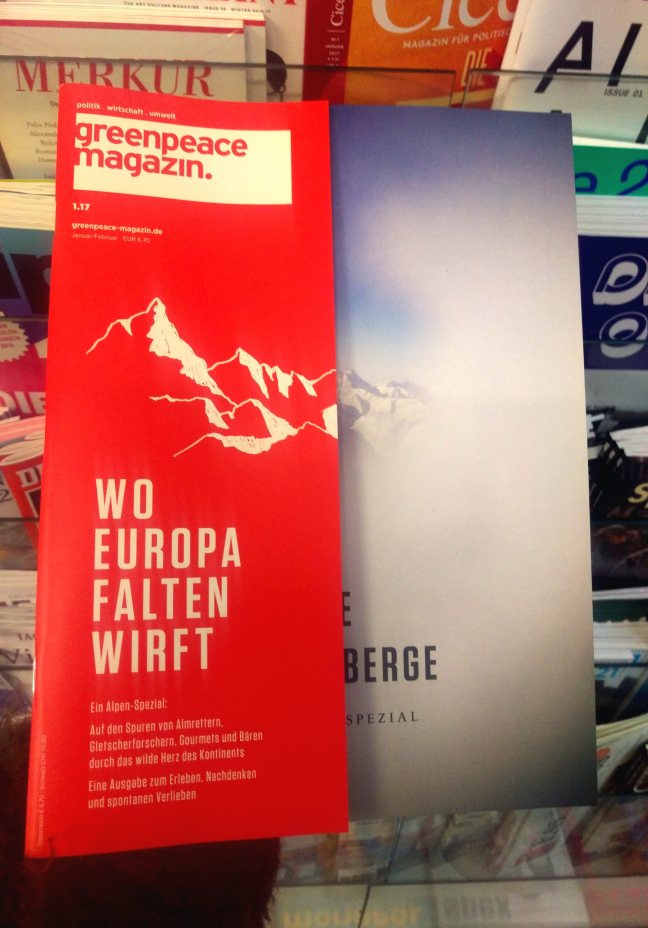I think I’m probably not the only one for whom ‘charity magazine’ carries a whiff of photocopied parish newsletters, or perhaps dull pages of generic blather and images that reek of middle England and middle age. Now I’m not for a second saying that’s all there is out there, but that there is still a certain stereotype that made it possible for me to be surprised and delighted when discovering something different on my most recent stay in Berlin
Greenpeace Magazin is a title that could hardly be more different to these tropes. It seems to hold its own against commercial and indie mags and has got me feeling optimistic and excited about opportunities for charities and social good orgs to use print editorial to inspire and share their values with the public.
Print revival
It is clear that print isn’t dead. While the days of high circulation magazines and newspapers, required-reading print are in decline in the West owing to rising production of and appetite for digital formats, indie publishing is having a huge revival.
Appetite grows for niche titles printed in batches sometimes only running to 5,000 or so. While some household name mags may be struggling, I’ve seen some estimates that about five indie magazines were launched in the UK alone each week over 2016 alone. The cover prices on some of these are £10 or more, positioning themselves outside the mass market. For their subscribers, it is a fair price.
Much has been said about the continued visual appeal of the printed page as a badge of identity, conviction and taste. Magazines’ ability to make a statement for their ‘communities’ of readers has caught the eye of brands and content marketers. N (Norwegian Airlines) and Ferment (the magazine included with a Beer52 subscription) are two personal favourites in the genre.
An opportunity for charities and social enterprises?
There are some nice charity examples I’m aware of such as the RSPB’s suite of printed titles for young supporters of different age groups. I really like Wingbeat, the magazine for teens that is guest edited by and features the photography of young supporters. And I can’t knock the National Trust mag. It’s not aimed at me but my hoarding dad keeps great stacks of them that no one is allowed to throw way, and has separate piles in his man drawer of bits that have been torn out.
But charity budgets for print magazines are falling and many more have gone online only, whether their content is properly adapted for digital or shoved into an awkward ‘e-magazine reader’ (*cough* *Issuu*).
All of which made discovering Greenpeace Magazin today while bumbling in Kreuzberg bookshops such an unexpected delight.

This magazine is beautiful first and foremost. That’s the first thing that strikes you: pages of stunning photojournalism, clever typography and clean editorial design (seemingly by designer Inka Schnettler). At €6.70 it’s beyond mass market but reasonably accessible to supporters. I’d like to know whether funds for charitable activities are raised through the mag or whether this counts as one of Greenpeace’s campaign interventions in Germany. There are no ads, though there are a few listings for products sold by Greenpeace at the back of the mag (think a wholesome, unbleached, ethically-produced, sustainable wood and natural fibre skipping rope) which I imagine also raise funds.

The second thing that stuck me was the lack of asks. If not outright donations most charity mags seem to be asking for something. There is very little of that here and for that reason it feels more ‘authentically’ like a magazine. It’s not an indie I’m sure but it has that vibe and that’s where it sat on the racks in this all liberal smorgasbord of a bookshop.

This December 2016 issue (yes I did take a few too many overenthusiastic shots of spreads at the rack) is focused on the theme of mountains of Europe. The articles look at wildlife (as we expect of Greenpeace) but also at culture, landscape, society and more (there was even a food bit!), all through this lens. It’s obvious when you think about it that this is because Greenpeace wants to protect mountain environments for all of the above things they hold, but it never bashes you over the head with it. It treats the reader as an adult with interests in culture, current affairs, travel, photography and the environment – interests that it too holds and wishes to share.
Though it’s image-led, there are longform feature articles (1500wds and more) and well as more bitesized content with facts and stats.

Can you tell yet that I really like this mag?
I was a regular Greenpeace supporter for a while so maybe I’m biased towards this as a title I would genuinely enjoy reading, but it was also so satisfying to see such a well executed product under a charity title.
It makes me excited about how charities and other orgs for social good can harness new approaches to print, alongside their digital, video and audio output to delight their supporters and explain their values and raison d’etre in a more relevant and interesting way.
There’s no reason other charities couldn’t do this (a quality magazine on it’s own right) in the right spaces, if they took this risk. I’m interested to learn more about the process here, I haven’t seen an equivalent to this in the UK – yet.
Have you seen any similar charity magazines of this type, in the UK or elsewhere? I’d love to find out if there are others.






